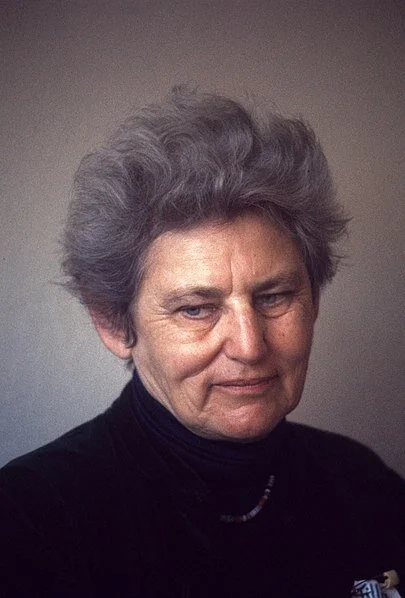A writer need not be prolific to be powerful. A speaker need not appear often to impact listeners. Tillie Olsen had to overcome society’s value of her gender, ethnicity, and politics, as well as her own mind, so that she could write about subjects in ways that foreshadowed the idea of intersectional feminism.
Olsen was born Tillie Lerner in Omaha, Nebraska, on January 14, 1912. Her parents, Ida Hashke Goldberg and Samuel Lerner, were secular Jews who fled Russia after working against the oppression they both felt. Even though they never married, the two raised their six children with a strong sense of socialist ideology and women’s equality, two social movements that do not necessarily complement each other. Her parents’ dedication to their beliefs often led to the family’s being targeted for their ethnicity and immigrant status, work in socialist political circles, and low income level compared to others living in their city. As result, her father held many different jobs over the years ranging from tenant farmer to peddler to candy maker.
Olsen was active in both body and mind as a child and teen. She wrote a humor column in her school newspaper under the penname “Tillie the Toiler” and was known for being unpredictable and for telling stories. For the 1920s her sexual adventures went beyond those acceptable for most girls, and she was pregnant by 16, though she did not have a child, either because of miscarriage or abortion. The school was frustrated with her, as were her parents, so Olsen left school during 11th grade in 1929 and left home not long afterward.
As open-minded as Olsen’s parents may have been in their time, she pushed their comfort zone and became part of the Young Communist League in 1930 or 1931 after leaving her parents’ home. Communism is not socialism; followers of the two social and political philosophies often clash. Olsen married a fellow radical, Abe Goldfarb, who was 17 years older but was someone with whom she could share a love of writing and ideology. Olsen worked so hard for her beliefs that she may have damaged her health, because she took a break from Nebraska and her older husband to recover in Minnesota with some relatives later in the 1930s. It was during this time that she tried to create her only novel, which was published in unfinished form in 1974. Publishers were interested in her novel, but Olsen focused more on political activism and never delivered on deadlines.
By 1932, Olsen had her first child, Karla, and her family moved to California, where their lives continued to be focused on political activism. By 1936, Olsen divorced Goldfarb and married Jack Olsen, another political ally and labor activist. A mysterious car accident killed Goldfarb the following year, though there is no serious connection between that death and Olsen. The new family expanded with three children, all daughters, and continued to struggle to remain true to their political ideologies while supporting a family of six. Both Olsen adults got involved in the local community through schools and labor unions as well as efforts to support the USA during World War II. However, both lost their jobs during the 1950s when the new enemy of democracy became communism.
Life as a wife and mother as well as loss of income allowed Olsen’s drive to write to rear up again. She took classes at San Francisco State College and was encouraged by the English faculty who taught her creative writing courses to keep writing. In 1955 and 1956 she won the Stegner Fellowship at Stanford University. Her short stories talked about the lives of women and mothers, of the poor and working classes, and of minorities. She started getting published and winning awards as well as earning some income for her family.
She started getting attention from publishers, and as she had before, she struggled to meet deadlines. Tell Me A Riddle(1961) is a collection of four short stories that is still in print today, used by English and women’s studies/feminism classes around the world; its stories have inspired three movies. The title story from that collection won the O’Henry Prizefor Best American Short Story that year as well. But Olsen’s mental and physical health once more deteriorated, and this time she was hospitalized.
From 1962-64 Olsen was able to attend Bunting (now Radcliffe) Institute for Independent Study to research other women writers. Through her studies she discovered common issues that many women writers had to overcome. She recognized that not only did their gender impede their lives but so did race, ethnicity, and economic status. Olsen’s own short work turned to look at these intersections, but she also started promoting unpublished works, using her own publishing power to get ignored works on the shelves of bookstores and libraries. Her collected essays on the connections between identities and the lack of published works was entitled Silences and was published in 1978. Some modern scholars credit her work with helping to develop women’s and minority studies programs in the USA.
Throughout the 1960s and into the early and mid-1980s, Olsen traveled around the United States and even to Europe to lecture, teach, and be interviewed. She continued to write her own essays and promote the works of others, even writing the introductions for several volumes. Once more, her mental and physical health paid the price, and she had to slow down.
When Olsen died on January 1, 2017, she held so many honors and positions that it would take hundreds of words to document them all. Considering that she dropped out before finishing high school, that she was an active political and social activist for most of her life, and that she had a family, her accomplishments are impressive. On top of all of that, her mental health issue, probably bipolar disorder or a similar condition, was an ongoing challenge.
Olsen’s life can teach us something important. Mental health does not mean that one can’t see the truth and fight for justice; it simply means that there may be challenges to accomplishing your goals while you try to care for yourself.



